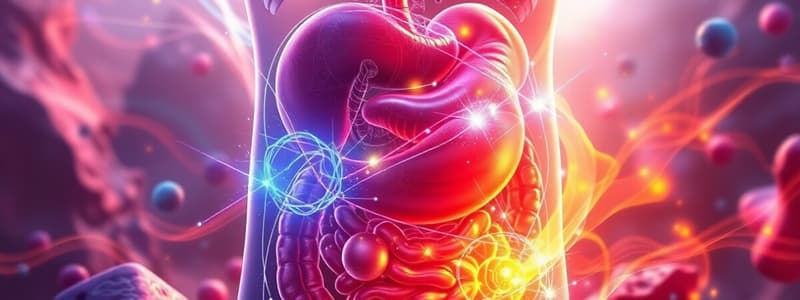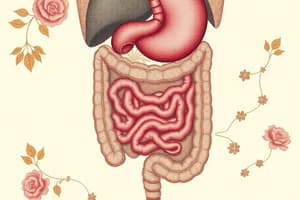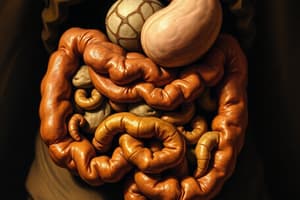Podcast
Questions and Answers
What is the primary function of mechanical digestion?
What is the primary function of mechanical digestion?
- Chemical modification of nutrients
- Absorption of nutrients into the bloodstream
- Egestion of waste materials
- Physical breakdown of food (correct)
Which organ primarily initiates the chemical digestion of carbohydrates?
Which organ primarily initiates the chemical digestion of carbohydrates?
- Small intestine
- Esophagus
- Mouth (correct)
- Stomach
What occurs during the egestion phase of digestion?
What occurs during the egestion phase of digestion?
- Removal of waste from the body (correct)
- Transfer of nutrients to the bloodstream
- Physical breakdown of food
- Chemical breakdown of macronutrients
What role does gastrin play in the stomach's digestive process?
What role does gastrin play in the stomach's digestive process?
What prevents food from entering the nasal passage during swallowing?
What prevents food from entering the nasal passage during swallowing?
What is chyme?
What is chyme?
What function does intrinsic factor serve in the digestive process?
What function does intrinsic factor serve in the digestive process?
What type of muscle contractions are involved in peristalsis?
What type of muscle contractions are involved in peristalsis?
During which phase of digestion does absorption predominantly occur?
During which phase of digestion does absorption predominantly occur?
What is the primary function of the esophagus?
What is the primary function of the esophagus?
What is the primary function of bile in the small intestine?
What is the primary function of bile in the small intestine?
Which part of the small intestine is primarily responsible for the majority of nutrient absorption?
Which part of the small intestine is primarily responsible for the majority of nutrient absorption?
What role do microvilli play in the small intestine?
What role do microvilli play in the small intestine?
What is the main consequence of untreated Pylori infection?
What is the main consequence of untreated Pylori infection?
Which enzyme is NOT found in pancreatic juice?
Which enzyme is NOT found in pancreatic juice?
How do lacteals function in the small intestine?
How do lacteals function in the small intestine?
What happens to most of the water present in the food as it passes through the colon?
What happens to most of the water present in the food as it passes through the colon?
Which segment of the large intestine connects to the small intestine?
Which segment of the large intestine connects to the small intestine?
What is the primary role of intestinal glands in the jejunum and ileum?
What is the primary role of intestinal glands in the jejunum and ileum?
Which statement about the anus is TRUE?
Which statement about the anus is TRUE?
Flashcards
Ingestion
Ingestion
The process of taking in nutrients through the mouth.
Digestion
Digestion
The physical and chemical breakdown of food into smaller molecules that the body can absorb.
Absorption
Absorption
The movement of nutrients from the digestive system into the bloodstream.
Egestion
Egestion
Signup and view all the flashcards
Mechanical Digestion
Mechanical Digestion
Signup and view all the flashcards
Chemical Digestion
Chemical Digestion
Signup and view all the flashcards
Saliva
Saliva
Signup and view all the flashcards
Peristalsis
Peristalsis
Signup and view all the flashcards
Gastroesophageal sphincter
Gastroesophageal sphincter
Signup and view all the flashcards
Gastric Juice
Gastric Juice
Signup and view all the flashcards
What is Helicobacter pylori?
What is Helicobacter pylori?
Signup and view all the flashcards
What is the small intestine?
What is the small intestine?
Signup and view all the flashcards
What is the duodenum?
What is the duodenum?
Signup and view all the flashcards
What is the jejunum?
What is the jejunum?
Signup and view all the flashcards
What is the ileum?
What is the ileum?
Signup and view all the flashcards
What are villi?
What are villi?
Signup and view all the flashcards
What are microvilli?
What are microvilli?
Signup and view all the flashcards
What is bile?
What is bile?
Signup and view all the flashcards
What is pancreatic juice?
What is pancreatic juice?
Signup and view all the flashcards
What is the large intestine?
What is the large intestine?
Signup and view all the flashcards
Study Notes
Digestive System Functions
- Breaks down large food molecules into smaller ones.
- Absorbs smaller molecules into the circulatory system for distribution to the body.
Human Digestive System Types
- Complete: Gastrointestinal tract with accessory organs.
- Simple: Opening and gastrovascular cavity.
Main Steps in Digestion
- Ingestion: Taking in nutrients.
- Digestion: Mechanical and chemical breakdown of nutrients.
- Absorption: Transfer of nutrients to the bloodstream.
- Egestion: Removal of waste.
Mechanical Digestion
- Physical breakdown of food.
- Increases surface area for better nutrient absorption.
- Occurs in the mouth, esophagus, and stomach.
Chemical Digestion
- Chemical breakdown of food.
- Breaks down macronutrients into smaller components.
- Glands release hormones that control enzymes (speed up chemical reactions).
- Occurs in the mouth, stomach, and small intestine.
Mouth
- Receives food, initiates digestion.
- Incisors and Canines cut food; Premolars and Molars grind food.
- Saliva, released by salivary glands (triggered by sight, smell, or presence of food), moistens and binds food into a bolus.
- Saliva contains amylase (digests starch to disaccharides) and mucus (lubricant).
Swallowing
- Tongue pushes bolus to the back of the mouth (voluntary).
- Food moves to the pharynx.
- Soft palate prevents food from entering the nasal passage.
- Epiglottis covers the airway.
- Pharyngeal muscles contract to force bolus into the esophagus (involuntary).
Esophagus
- Carries food from pharynx to stomach.
- Peristalsis (wave-like muscular contractions) moves food down.
- Gastroesophageal sphincter (circular muscle) regulates food entry to the stomach.
- Prevents acid reflux (heartburn).
Stomach
- J-shaped, muscular organ, stores up to 2 liters of food.
- Four layers: mucosa, submucosa, muscularis, serosa.
- Mucosa: Folds, secretes gastric juice (cells replaced every three days).
- Submucosa: Connective tissue, nerves, blood vessels.
- Muscularis: Smooth muscle, churns food with gastric juice to create chyme.
- Serosa: Outermost layer, holds stomach in place, lubricates.
Stomach: Chemical Digestion
- Gastrin hormone released to stimulate gastric juice secretion.
- Gastric juice contains enzymes, acid, mucus, and intrinsic factor.
- HCl kills pathogens, activates pepsinogen to pepsin, and begins protein breakdown.
- Mucus protects stomach lining from digestion.
- Intrinsic factor is needed for B12 absorption.
Stomach: Mechanical Digestion
- Food stimulates muscular contractions to mix with gastric juices.
Stomach: Absorption
- Small amounts of water, glucose, ions, and alcohol absorbed.
Stomach Ulcers
- H. pylori bacteria neutralize stomach acid and burrow into the mucosa.
- Reduced mucus production exposes the stomach lining to acid, causing ulcers.
- Treated with antibiotics.
Small Intestine
- ~20 feet long, 1 inch in diameter.
- Main site of chemical digestion and nutrient absorption.
- Three sections: duodenum (digestion), jejunum (digestion and absorption), ileum (absorption).
- Villi and microvilli greatly increase surface area, maximizing absorption.
- Capillaries absorb all nutrients except fats, which are absorbed by lacteals.
Duodenum
- Chyme enters from the stomach.
- Peristalsis moves chyme.
- Bile and pancreatic juice are added.
Bile
- Produced in liver, stored in gallbladder.
- Enters the small intestine through the common bile duct.
- Aids in fat digestion and absorption.
Pancreatic Juice
- Pancreas produces, released through pancreatic duct.
- Contains amylase (starch digestion), trypsin (protein digestion), and lipase (fat digestion).
- Bicarbonate ions neutralize stomach acid.
Jejunum and Ileum
- Digestion and absorption of nutrients continue.
- Intestinal glands secrete enzymes (carbohydrases, peptidases) for further digestion.
Liver and Gallbladder
- Liver removes sugar (glucose) excess stored as glycogen
- Removes amino acids and produces bile (bile salts aid digestion).
- Blood from intestines passes through liver before returning to the heart.
Pancreas
- Secretes enzymes for digestion.
- Secretes hormones that regulate glucose levels.
Large Intestine
- ~1.5 meters long, 7.6 cm diameter.
- Water reabsorbed, waste remains, forms feces
- Houses gut bacteria (beneficial).
- 4 segments (ascending, transverse, descending, sigmoid).
- Rectum stores feces.
Egestion
- Indigestible components keep you full, retain water to aid elimination.
Anus
- Two sphincter muscles (internal - involuntary, external - voluntary).
Studying That Suits You
Use AI to generate personalized quizzes and flashcards to suit your learning preferences.



